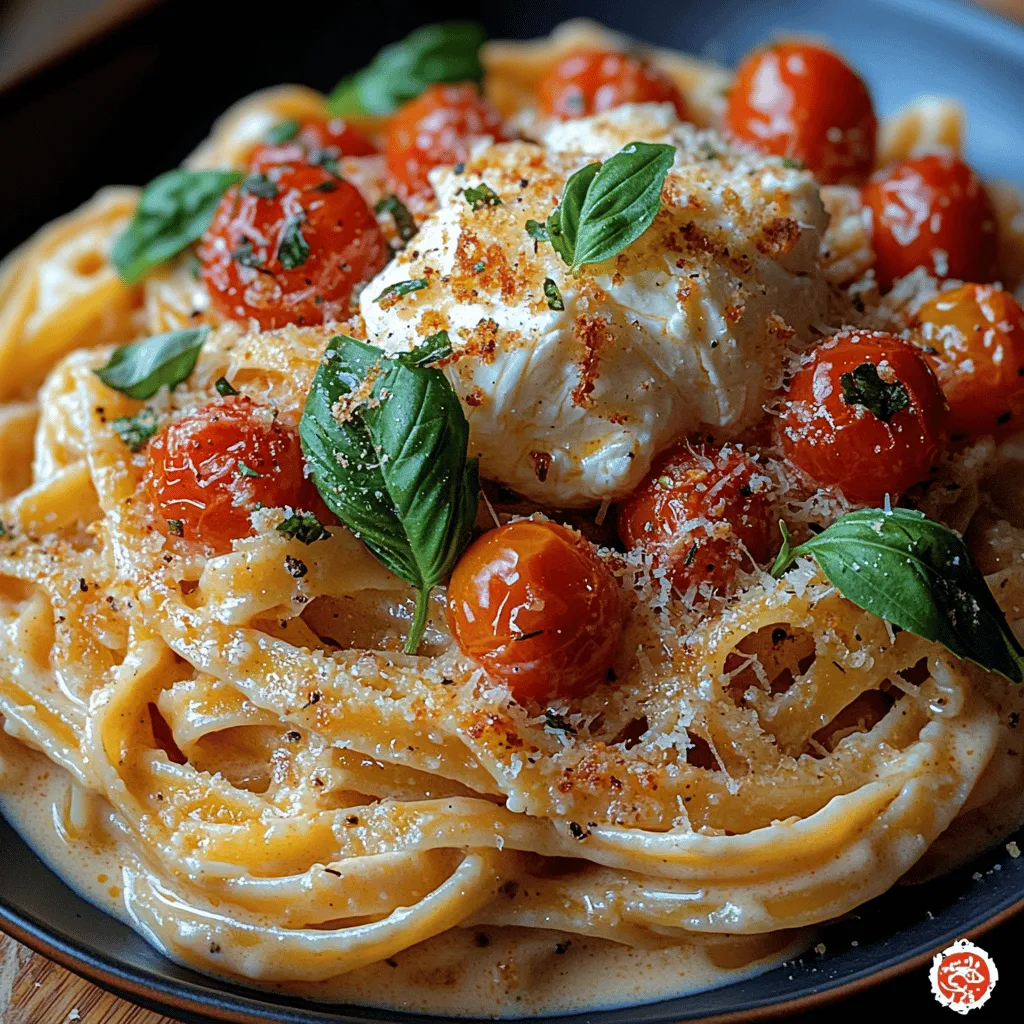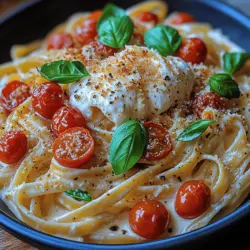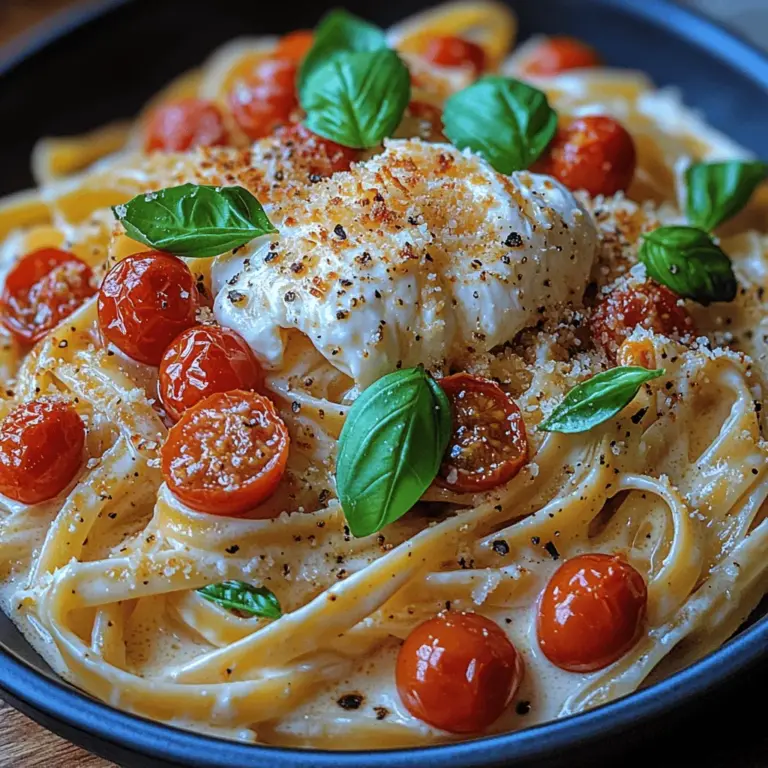Introduction
Creamy Burrata Pasta is a dish that brings together the best of Italian cuisine in a single, delightful meal. With its rich and velvety sauce, this pasta dish is not only comforting but also incredibly satisfying, making it perfect for a family dinner or a special occasion. The use of burrata cheese elevates this recipe to new heights, providing a luxurious creaminess that melts in your mouth. This dish is a wonderful blend of textures and flavors, showcasing the luscious creaminess of the burrata, the al dente pasta, and vibrant, fresh ingredients.
As we delve into this recipe, we’ll explore the unique aspects that make Creamy Burrata Pasta a favorite among home cooks and food enthusiasts alike. From the creamy sauce that envelops the pasta to the sweet burst of cherry tomatoes and the aromatic touch of fresh basil, each component plays a critical role in creating a harmonious dish that is sure to impress.
The Allure of Creamy Burrata Pasta
Overview of Burrata Cheese
Burrata cheese, originating from southern Italy, particularly the Puglia region, is a fresh cheese made from mozzarella and cream. It features a delicate outer layer of mozzarella that encases a rich and creamy interior, creating a delightful contrast in textures. When you slice into burrata, the creamy center spills out, adding an indulgent element to any dish. The flavor is mild and slightly sweet, making it an excellent addition to pasta, salads, or simply served with bread.
In the context of Creamy Burrata Pasta, this cheese acts as the star ingredient, contributing a luxurious creaminess that is difficult to replicate with other types of cheese. The combination of burrata with fresh pasta creates a dining experience that is both comforting and refined, appealing to cheese lovers and pasta aficionados alike.
Importance of Fresh Ingredients in Italian Cuisine
Italian cuisine places a strong emphasis on the quality of its ingredients; fresh and seasonal produce is the cornerstone of any great Italian dish. When preparing Creamy Burrata Pasta, using fresh ingredients not only enhances the flavors but also ensures that the dish is vibrant and appealing. Each element, from the pasta to the herbs, contributes to the overall taste and presentation.
In this recipe, we’ll be focusing on the synergy between cream, tomatoes, basil, and garlic. The sweetness of cherry tomatoes balances the richness of the cream and burrata, while fresh basil adds a fragrant note that ties everything together. This balance of flavors is what makes Italian cuisine so beloved around the world.
Ingredients Overview
To create the perfect Creamy Burrata Pasta, you’ll need a selection of high-quality ingredients. Here’s a detailed description of each component:
– Fettuccine or Tagliatelle: These pasta shapes are ideal for this dish due to their ability to hold onto the creamy sauce. Fettuccine, with its flat and wide noodles, provides a hearty base that complements the richness of the sauce. Tagliatelle, similarly, has a slight chewiness that works wonderfully with the creamy texture.
– Olive Oil: A staple in Italian cooking, olive oil is used not just for cooking but also for drizzling over the finished dish. It contributes to the overall flavor profile and helps to sauté the garlic, releasing its aroma and enhancing the sauce.
– Garlic: Fresh garlic is essential in building the flavor base for this pasta. Its aromatic qualities elevate the dish, adding depth and a savory note that pairs beautifully with the cream and cheese.
– Cherry Tomatoes: These bite-sized fruits bring a natural sweetness and acidity that balances the richness of the cream and burrata. When cooked, they burst open, releasing their juices and creating a vibrant sauce.
– Fresh Basil: The aromatic qualities of fresh basil are a defining element in this recipe. It adds a fragrant herbal note that brightens the dish and complements the creamy sauce perfectly.
– Heavy Cream and Lemon Zest: The heavy cream is crucial for achieving that luscious, creamy texture in the sauce. Lemon zest adds a bright, zesty flavor that cuts through the richness, providing a refreshing contrast.
– Burrata: The star of the dish, burrata adds an unparalleled creaminess and richness. It’s best to add it at the end of the cooking process to maintain its delicate structure and soft texture.
– Parmesan Cheese: Grated Parmesan cheese enhances the umami flavor of the dish, adding depth and a salty component that balances the creaminess.
– Salt and Pepper: Essential for seasoning, salt and pepper bring out the flavors of all the ingredients, ensuring a well-rounded dish.
Preparation Steps Explained
Now that you have a good understanding of the ingredients, let’s move on to the preparation steps. This section will guide you through creating your Creamy Burrata Pasta, ensuring that you achieve the best results.
1. Cook the Pasta: Start by bringing a large pot of salted water to a boil. Add your fettuccine or tagliatelle and cook according to the package instructions until al dente. Remember to reserve about one cup of pasta water before draining the pasta. This starchy water will be useful for adjusting the sauce’s consistency later.
2. Sauté the Garlic: In a large skillet, heat a generous amount of olive oil over medium heat. Once the oil is hot, add minced garlic and sauté for about 1-2 minutes until fragrant, being careful not to let it brown, as this can introduce a bitter flavor.
3. Add Cherry Tomatoes: Next, add the halved cherry tomatoes to the skillet. Cook them for about 5-7 minutes, stirring occasionally, until they begin to soften and release their juices. This will create a natural sauce that forms the base of your dish.
4. Incorporate Heavy Cream: Reduce the heat to low and pour in the heavy cream. Stir to combine with the tomatoes and garlic, allowing the mixture to simmer gently for a few minutes. This step helps to meld the flavors together while creating a rich, creamy sauce.
5. Season the Sauce: At this point, add freshly grated lemon zest, salt, and pepper to the sauce. Taste and adjust the seasoning as needed. The lemon zest will provide a bright, zesty flavor that balances the creaminess of the sauce.
6. Combine Pasta and Sauce: Once the pasta is cooked and drained, add it directly to the skillet with the creamy tomato sauce. Toss to combine, ensuring the pasta is thoroughly coated in the sauce. If needed, gradually add reserved pasta water to achieve your desired sauce consistency.
7. Add Burrata: Finally, gently tear the burrata into pieces and place it on top of the pasta. The residual heat from the pasta will begin to melt the cheese, creating an even creamier dish. Finish with a sprinkle of freshly grated Parmesan cheese and a few torn basil leaves for garnish.
These steps will guide you in creating a sumptuous Creamy Burrata Pasta that is sure to impress anyone at your dinner table. With the right ingredients and attention to detail, you’ll be able to enjoy a dish that not only tantalizes the taste buds but also provides a comforting and satisfying meal.
Stay tuned for the next part of the article, where we will dive deeper into tips for achieving the best results and answer some common questions about this delectable dish.

Cooking the Pasta Al Dente: Importance of Texture
To achieve the perfect Creamy Burrata Pasta, cooking the pasta to an al dente texture is crucial. Al dente, which translates to “to the tooth” in Italian, means that the pasta should be firm when bitten. This texture not only enhances the overall eating experience but also allows the pasta to hold its shape when mixed with the creamy sauce.
When boiling your pasta, be sure to follow the package instructions for cooking times, but start checking a minute or two earlier. This will help you avoid overcooking, which can lead to mushy pasta that doesn’t hold up well in the dish. Once cooked, reserve about a cup of the pasta water before draining. This starchy water is an essential ingredient that can help adjust the sauce’s consistency later on.
Sautéing Garlic and Tomatoes: Techniques for Maximizing Flavor
Sautéing is a fundamental technique in Italian cooking that enhances the flavors of your ingredients, particularly garlic and tomatoes. Begin by heating a generous amount of olive oil in a large skillet over medium heat. Once the oil is shimmering, add finely minced garlic. Sauté the garlic until it’s fragrant, typically around 30 seconds to one minute, being careful not to let it burn as that can impart a bitter taste.
Next, add your halved cherry tomatoes or diced tomatoes to the skillet. As they cook, they will release their juices, which will infuse the oil and garlic, creating a flavorful base for your sauce. Stir occasionally and allow the tomatoes to soften and caramelize slightly, about 5 to 7 minutes. This caramelization process will deepen the flavor of your sauce, making it more robust and appealing.
Creating the Cream Sauce: Balancing Heat and Simmering Time
The cream sauce is what makes this pasta dish truly decadent. After sautéing the garlic and tomatoes, it’s time to incorporate the cream. Lower the heat to medium-low and pour in your heavy cream, whisking gently to combine. The key here is to let the cream simmer for about 3 to 5 minutes, allowing it to thicken slightly while blending with the tomato and garlic mixture.
For an added depth of flavor, consider seasoning the sauce with salt, pepper, and a pinch of red pepper flakes for a hint of heat. The simmering process is crucial; it allows the flavors to meld together beautifully while preventing the cream from boiling, which could cause it to separate.
Combining Pasta with Sauce: Importance of Pasta Water for Consistency
Once your cream sauce has reached the desired consistency, it’s time to bring everything together. Add the drained pasta directly into the skillet with the sauce. This step is essential as it allows the pasta to absorb some of the creamy sauce, ensuring every bite is rich and flavorful.
Incorporate the reserved pasta water gradually. Start with a few tablespoons and mix well. This starchy water will not only help to loosen the sauce but also enhance its creaminess. Continue adding more water until you achieve the desired consistency; the sauce should coat the pasta beautifully without being overly runny.
Incorporating Burrata and Basil: Techniques for Achieving the Perfect Melt
The final touch to your Creamy Burrata Pasta is adding the burrata and fresh basil. Tear the burrata into pieces and gently fold it into the pasta mixture just before serving. The heat from the pasta will cause the burrata to melt slightly, creating a luscious and creamy texture that elevates the dish.
For freshness, add freshly torn basil leaves just before plating. The aroma and flavor of basil will brighten the dish, balancing the richness of the cream and the cheese. Remember, adding the burrata and basil at the end ensures that they maintain their integrity and flavor.
Serving Suggestions: Presentation and Garnishing Tips
Presentation is key when serving Creamy Burrata Pasta, as it’s a dish that is as visually stunning as it is delicious. Use large, shallow bowls or plates to serve the pasta, allowing the creamy sauce to pool beautifully around the pasta. For a touch of elegance, garnish with additional torn basil leaves and a sprinkle of freshly grated Parmesan cheese.
A drizzle of high-quality extra virgin olive oil over the top can add a glossy finish and enhance the flavors further. For a pop of color and an extra layer of flavor, consider adding some cherry tomatoes on top or a sprinkle of crushed red pepper flakes.
Nutritional Benefits of the Ingredients
Overview of the Health Benefits of Key Ingredients
1. Pasta as a Source of Carbohydrates for Energy: Pasta is primarily composed of carbohydrates, which are essential for providing energy. When consumed in moderation, pasta can be part of a balanced diet, offering a source of sustained energy for daily activities and exercise.
2. Benefits of Tomatoes: Tomatoes are rich in essential vitamins such as vitamin C and K, as well as antioxidants like lycopene, which is linked to many health benefits, including reduced risk of chronic diseases. They also contribute to skin health and hydration.
3. Garlic’s Health Properties: Garlic is known for its anti-inflammatory and immune-supporting properties. It contains compounds like allicin, which can help lower blood pressure and cholesterol levels, making it a heart-healthy addition to your diet.
4. Basil: This fragrant herb is not only a flavorful addition but also boasts several health benefits. Basil is rich in vitamins A, K, and C, along with essential oils that have anti-inflammatory and antibacterial properties.
5. Burrata and Cream: While rich and indulgent, it’s important to enjoy burrata and cream in moderation. They provide calcium and healthy fats, which are beneficial for bone health and energy, but should be balanced with other nutrient-dense foods.
Perfect Pairings for Your Creamy Burrata Pasta
Suggested Wine Pairings
When it comes to pairing wine with Creamy Burrata Pasta, a light white wine is your best bet. Consider options such as a Pinot Grigio or a Sauvignon Blanc. These wines have crisp acidity that can balance the richness of the cream and complement the flavors of the tomatoes and garlic without overpowering them.
Side Dishes
For side dishes that harmonize with your pasta, consider a simple arugula salad dressed with lemon vinaigrette. The peppery flavor of arugula will contrast nicely with the creamy pasta. Alternatively, roasted vegetables or a light antipasto platter featuring olives and marinated artichokes would complement the meal beautifully.
Bread Suggestions
No Italian meal is complete without bread. A crusty baguette or a slice of focaccia would be perfect for soaking up any remaining sauce. If you’re looking for something more traditional, garlic bread would also be a great accompaniment, enhancing the overall flavor profile of the dish.
Storing and Reheating Leftovers
Best Practices for Storing Leftover Creamy Burrata Pasta
If you have leftover Creamy Burrata Pasta, store it in an airtight container in the refrigerator. It’s best to consume leftovers within 2 to 3 days for optimal freshness. If you anticipate having leftovers, consider storing the burrata separately to maintain its texture and creaminess.
Tips for Reheating to Maintain Texture and Flavor
When reheating, it’s important to do so gently to avoid overcooking the pasta or causing the cream to separate. Place the pasta in a skillet over low heat, adding a splash of reserved pasta water or stock to help loosen the sauce. Stir occasionally until heated through, then add the burrata just before serving to allow it to melt slightly without becoming rubbery.
Conclusion
Creamy Burrata Pasta is a delightful dish that combines the richness of cream, the freshness of tomatoes, and the luxurious melt of burrata cheese. It exemplifies the comfort and simplicity of Italian cooking, making it an excellent addition to your culinary repertoire.
Not only is it easy to prepare, but the flavors are also incredibly satisfying, providing a comforting meal that is perfect for any occasion. Whether it’s a weeknight dinner or a special gathering, this pasta dish is sure to impress. So gather your ingredients, follow the steps, and indulge in the creamy goodness of this delightful recipe. Enjoy your culinary journey, and celebrate the richness of flavors that come together in this exquisite Creamy Burrata Pasta.


